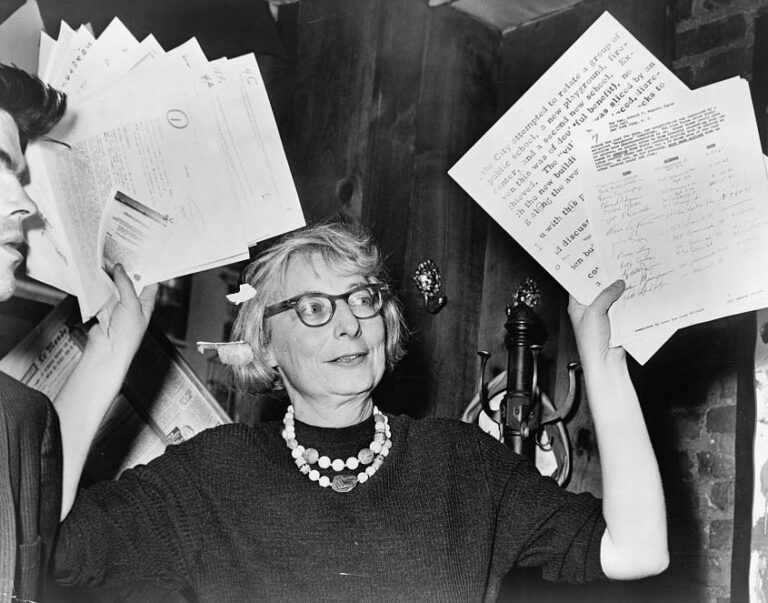Physical Address
304 North Cardinal St.
Dorchester Center, MA 02124
Physical Address
304 North Cardinal St.
Dorchester Center, MA 02124

When I first became interested in urban planning, I believed a piece of professional mythology that went like this: “For all its faults, Euclidean zoning was a well-meaning effort to expand nuisance regulation in the face of the urban industrialization. It was later practitioners who used zoning for selfish and exclusionary purposes.” While not totally without basis, I now think this view is wrong. Today I would like to show how the iconic example of a nuisance that supposedly motivated Euclidean zoning—the Equitable Life Building in New York City—was in large part controversial because it threatened the interests of existing landlords. The Equitable Life Building at 120 Broadway was completed in 1915. A vanity project of an industrialist—Thomas Coleman duPont—as so many skyscrapers were and are, the projected stood 42-stories high across an entire block without setbacks, adding a startling one and a quarter million square feet of rentable office space to Lower Manhattan. Needless to say, some New Yorkers weren’t happy. But why? The conventional wisdom holds that the Equitable Life Building caused such a stir because it literally cast a shadow over the rest of the neighborhood. Indeed, the building cast a shadow stretching nearly a fifth of a mile across Broadway. But it wasn’t just the shadows that made the Equitable Life Building so uniquely audacious—after all, it wasn’t the tallest building in the neighborhood (this honor would go to the Woolworth Building, completed four years earlier 1912) and it wasn’t the first skyscraper to take up an entire city block without setbacks (by this point, the Flatiron Building was already an icon of the city). Rather, what made the project especially upsetting, on top of standard concerns about light and air, was that it was adding so much floor space at a time when the Lower […]

On June 24 in Brooklyn, a driver in an SUV struck and killed four-year-old Luz Gonzalez, with many onlookers claiming the incident was a hit-and-run. The New York Police Department disagrees, and has refused to prosecute the driver, sparking multiple street protests. Beyond seeking justice for Gonzalez, activists demand that the city expand the use of speed cameras in school zones, which they hope could prevent further tragedy. Yet precisely at the moment that the community is most sensitive to the risk that dangerous driving poses to children, the New York state legislature shut off 140 school zone speed cameras. Given their unambiguous success in improving traffic safety in school zones, legislators should act now to renew and expand the program. While there is rare consensus among Governor Andrew Cuomo and Mayor Bill de Blasio on the need to preserve and even expand the traffic camera program to 290 cameras, the expansion faces opposition from some members in the Senate. Opposition to the cameras has been lead by Republican State Senator Martin J. Golden—himself a notorious school zone speeder, having received over 10 tickets since 2015 alone—and Democrat State Senator Simcha Felder, who ineffectively used the cameras as a bargaining chip to install police officers in schools. Since their implementation in 2014 as part of the broader Vision Zero initiative, school zone speed cameras have already substantially improved pedestrian safety in New York’s school zones. According to one study by the New York City Department of Transportation, the number of people killed or seriously injured in crashes in schools zones has fallen by 21 percent to 142 since the cameras came online. This is due in part to the fact that speeding drivers are getting the message: in the first 14 months following implementation of cameras, speeding violations in school […]
by Samuel R Staley Before the twentieth century land-use and housing disputes were largely dealt with through courts using the common-law principle of nuisance. In essence if your neighbor put a building, factory, or house on his property in a way that created a measurable and tangible harm, courts could intervene on behalf of a complainant to force compensation or stop the action. This pro-property rights approach maximized liberty and minimized the ability of citizens and elected officials to politicize the development process. This changed with the Progressive movement. Beginning in the late nineteenth century, Progressives argued that government should become more professional. Rather than being limited, government should use its resources to pursue the “public interest,” loosely defined as whatever the general public decided through democratic processes was the proper scope of government. Legislatures and, by extension, city commissions made up of elected citizens would set policy and goals while a cadre of trained professionals would use the techniques of scientific management to implement policies. One of the leading Progressives of the day, Woodrow Wilson, was skeptical of the value of elected bodies such as Congress because they interfered with scientific management of government. While many in the twenty-first century might be tempted to dismiss this public-interest view of government—indeed an entire academic subdiscipline, Public Choice, has emerged to demonstrate the foibles of governments and explore “government failure”—Progressive ideas held a lot of appeal at the turn of the twentieth century. In addition to national concerns over industries such as oil, steel, and railroads, local governments were rife with corruption, waste, and inefficiency. Reforms, such as the city-manager form of government, civil-service exams, and in some cases even municipal ownership of utilities, were thought to provide more transparency and accountability than the patronage-laden times of political bosses. (Today municipal […]

My guest this week is Sanford Ikeda, a professor of economics at SUNY Purchase and a visiting scholar at New York University. He has written extensively on urban economics, policy, and planning. Professor Ikeda introduced me to urban economics and urban planning when he gave a presentation on Jane Jacobs at a FEE summer seminar that I attended back in 2012. Here are a few of the topics we discussed in the episode: If you haven’t already, I highly suggest reading Jane Jacobs. The natural place to start is The Death and Life of Great American Cities. Her other books, including The Economy of Cities and Systems of Survival, explore topics ranging from economics to political philosophy. Professor Ikeda has written extensively on Jane Jacobs. You can read a nice overview here. If you would like to read more, click here for a paper he wrote on F.A. Hayek, Jane Jacobs, and the importance of local knowledge in cities. He is also a regular contributor to Freeman and Market Urbanism. We also discussed William H. Whyte’s famous documentary on public space, The Social Life of Small Urban Spaces. It’s well worth checking out. Help spread the word! If you are enjoying the podcast, please subscribe and rate us on your favorite podcasting platform. Find us on iTunes, PlayerFM, Pocket Casts, Stitcher, and Soundcloud. Our theme music is “Origami” by Graham Bole, hosted on the Free Music Archive.
California Assembly Bill 710 was introduced to earlier this year to tackle the problem of municipalities requiring onerous amounts of parking for new development, widely recognized as one of the main impediments to transit-oriented development and infill growth. The bill would have capped city and county parking requirements in neighborhoods with good transit to one space per residential unit and one space per 1,000 sq. ft. of non-residential space, with an exemption process for areas with a true parking crunch and some other caveats….
by Stephen Smith Back in February Streetsblog had a good three–part series on planning changes in New York City since the beginning of Michael Bloomberg’s term, and while they had a lot of praise for upzonings that have occurred throughout much of the four urban boroughs, they highlighted minimum parking regulations as the biggest impediment to walkable, transit-oriented development. The series ran a few months ago, but I was reminded of it because of Tyler Cowen’s article in the New York Times a few days ago, in which he made the same general Donald Shoup-esque arguments about parking that readers of Market Urbanism are familiar with. But back to the Streetsblog series – the second part is mostly about parking minimums in NYC, which haven’t been lowered despite the upzonings and other policies that emphasize mass transit over cars. The article has a great map which shows that, outside of areas south of Central Park, parking minimums are barely relaxed at all in areas of all five boroughs with the best transit access, and this paragraph sums up the paradox of New York’s planning regulations pretty well: Perversely, because you can build more densely near transit, parking minimums per square foot of land are actually higher where transit options are most robust. So even as the planning department tries to concentrate growth near transit lines, it is simultaneously filling that valuable real estate with unnecessary parking. As one commenter points out, the Department of City Planning probably isn’t intentionally sabotaging its walkability goals – many current residents own cars and want to continue to use them, and a development’s car-less residents from the hypothetical future don’t get a say in local politics. Fast-forward a few months, though, and it looks as though the City Planning Department may be reconsidering its […]
I’m a little slow picking up on this one, but the Wall Street Journal recently interviewed Harvard Urban Economist, Ed Glaeser. Here are some excerpts from State of the City: THE WALL STREET JOURNAL: What effect will higher gasoline prices have on urban planning in the U.S.? MR. GLAESER: I would be very surprised to see a wholesale change in the nature of American urban development. We should certainly see changes in the short run, [such as] a slight decrease in demand for housing that’s particularly far away from city centers and dependent on long drives. That [type of housing] won’t be abandoned entirely, but it will certainly be cheaper. WSJ: What about the idea of having the government purchase foreclosed homes and convert them into affordable housing? Would that be good for the economy? MR. GLAESER: The government’s track record as a property owner is not so great. I am less enthusiastic about the government getting into this business. If we want strong policies towards taking care of the least well-off in our society, we should make sure supply is unfettered and continue working on the Section 8 [low-income housing] voucher program — that’s the right strategy. Glaeser discusses Chicago’s success: MR. GLAESER: I think Chicago has been remarkably successful in lots of ways. The city has managed to stay pretty affordable and Mayor [Richard] Daley has been extremely pro-growth. Chicago, for many years, has had a relatively pro-growth environment, at least relative to California and New York — especially [before current Mayor Michael Bloomberg]. The climate in Chicago is, of course, far less pleasant than San Francisco and wages are lower than New York. Still, it is somewhat remarkable that condo prices in Chicago [a median $232,000 in 2007] are less than those in Trenton, N.J. [$248,000], and […]